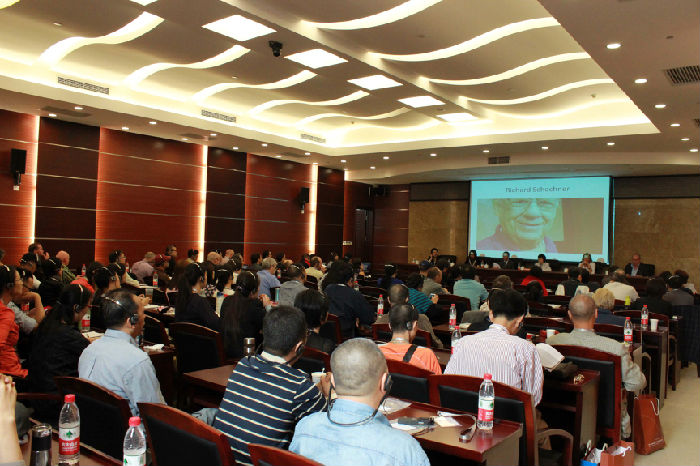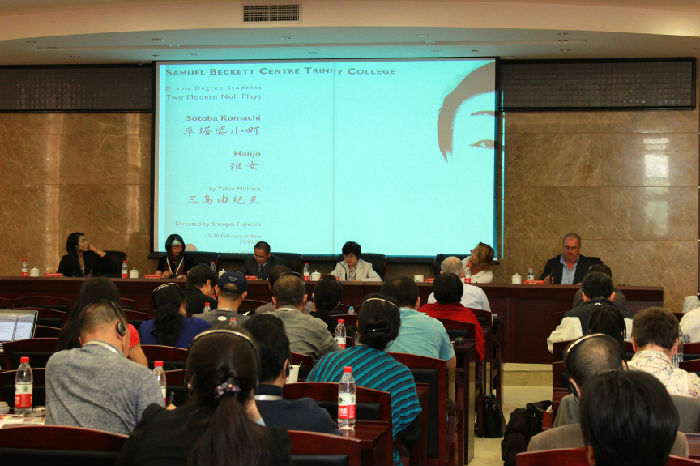
On the morning of May 19, the 1st World Theatre Education Convention was held at then Central Academy of Drama, China (CAD). Four scholars, respectively from Ireland, Germany, China and Korea, shared their papers, and had heated discussions with the audience.
The first speaker was Professor Brian Singleton, Head of School of Drama, Film & Music, Trinity College Dublin. In his paper “Ritual and Tradition of Asian Performance in an Irish Educational and Training Context”, he discussed the influence of traditional Asian dramas on Irish higher education of drama in the past three decades, as well as the obstacles and channels of cross-cultural communication in the context of globalization. Based on his rich collection of documents and videos about Asian drama, and his person-to-person contact with many Asian screenwriters, directors and actors, he believed that there were two main aspects of Asian cross-culturalism, namely the admiration for Western cultures and the excavation of traditions. By integrating Asian drama elements into Irish drama performance, they gained new experience in teaching students the dramaturgy, movement, sound, or other aspects in the experimental drama, and had new clues on how to produce Asian plays in Irish context.
Prof. Margarete Schuler with University of Performing Arts Ernst Busch shared her experience of teaching the Ernst Busch’s way of acting in Shanghai Theatre Academy, including how to instruct Western and Eastern students with different mentalities. In her answer to a question from the audience, she mentioned that the key of education in Ernst Busch was not to teach students to express their feelings or arouse sympathy among the audience, but to tell them to interact and connect with the audience through vocal and body language. She added that the students should leverage the techniques and bring up paradox using analytics and dialectics. She then further introduced the syllabus of the two-year China-Germany education programme, which included reading, scene study, gesture, and speech, and the idea was to explore the possibility of postmodernist drama in China based on the framework of traditional European realism.

The third speaker was Ms. Li Yinan from the Department of Dramatic Literature of CAD, who shared her paper “The Design, Practice and Achievements of Teaching Dramaturgy in the Central Academy of Drama”. She had been dedicated to the studies of theatre and dramaturgy, as well as the introduction of Dramaturgy, originated from Germany, to China. Supported by CAD, Dramaturgy had become a specialized course in the syllabus of the Department of Dramatic Literature. She touched upon the concept, evolution and her interpretation of Dramaturgy, which sparked heated discussions. The highlight of her speech was her presentation of the pictures of her students’ practices, which proved the success of Dramaturgy in China. This innovative approach enhanced the influence of theatre arts in the era of the Internet, and would boost the overall development of Chinese theatre.

The last speaker was Prof. Lee Kwang-Bok from Seokyeong University. In her paper “The Impact of Integrating Drama with Other Art Forms on Performance Education: the Necessity of Practical Performance Education". Prof. Lee had studied Peking Opera in National Academy of Chinese Theatre Arts, and had gained insightful observations on the body language in this art form. In her paper, she focused on practical performance education, and elaborated on the practice of theatre education by introducing the integration of all theatrical forms. She pointed out that many of the students of acting in Korea did not received professional education before they entered the college, so the teachers needed to help the students develop their own body language by better grasping the traits of their bodies. She also brought up the concept of "one-person creator", which meant the actor was also the creator, and should produce a better character after perceiving director's intentions, music, lighting, and stage design. This concept could, she added, not only stimulate the actors, but also enhance their overall qualities and the perception of the script, and thus the actors’ expressive power. She believed that it was undoubtedly a successful practice for the training of actors’ comprehensive strengths.

